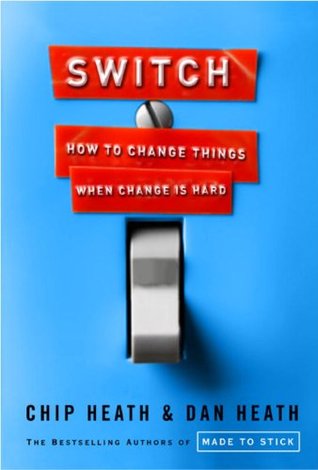More on this book
Community
Kindle Notes & Highlights
by
Chip Heath
Read between
August 31 - September 28, 2014
what looks like a “character problem” is often correctible when you change the environment.
Simple tweaks of the Path can lead to dramatic changes in behavior.
To change yourself or other people, you’ve got to change habits,
action triggers can have a profound power to motivate people to do the things they know they need to do.
Gollwitzer says that action triggers “protect goals from tempting distractions, bad habits, or competing goals.
Gollwitzer says that, in essence, what action triggers do is create an “instant habit.” Habits are behavioral autopilot,
A good change leader never thinks, “Why are these people acting so badly? They must be bad people.” A change leader thinks, “How can I set up a situation that brings out the good in these people?
It’s easier to persevere on a long journey when you’re traveling with a herd.
We all talk about the power of peer pressure, but “pressure” may be overstating the case. Peer perception is plenty.
You are doing things because you see your peers do them.
A groundbreaking study led by Dr. Nicholas Christakis of Harvard Medical School, which followed 12,067 people for thirty-two years, found that when someone became obese, the odds of that person’s close mutual friends becoming obese tripled!
Christakis said, “You change your idea of what is an acceptable body type by looking at the people around you.
When you’re leading an Elephant on an unfamiliar path, chances are it’s going to follow the herd. So how do you create a herd?
If you want to change the culture of your organization, you’ve got to get the reformers together. They need a free space. They need time to coordinate outside the gaze of the resisters.
Counterintuitively, you’ve got to let your organization have an identity conflict. For a time, at least, you’ve got to permit an “us versus them” struggle to take place. We know this violates our “we’re all on the same team,” Kumbaya-ish instincts. It’s not desirable, but it’s necessary. Think of it as organizational molting.
So, yes, a long journey starts with a single step, but a single step doesn’t guarantee the long journey. How do you keep those steps coming?
The first thing to do is recognize and celebrate that first step.
When you spot movement, you’ve got to reinforce it.
although inertia may be a formidable opponent in the early goings of your switch, at some point inertia will shift from resisting change to supporting it. Small changes can snowball to big changes.
When change works, it tends to follow a pattern. The people who change have clear direction, ample motivation, and a supportive environment. In other words, when change works, it’s because the Rider, the Elephant, and the Path are all aligned in support of the switch.
Change follows a pattern. What’s not part of the pattern is the type of person who’s doing the changing.
Problem: People don’t see the need to change.
find the feeling.
Create empathy.
Tweak the environment so that whether people see the need to change is irrelevant.
Problem: The environment has shifted, and we need to overcome our old patterns of behavior.
Can you create a new habit so the Rider doesn’t constantly have to wrestle the Elephant?
creating a routine for the morning that eliminates the old, bad behavior.
Problem: People simply aren’t motivated to change.
“sell” the new identity
take a small step toward the new identity,
Create a destination postcard that makes the chang...
This highlight has been truncated due to consecutive passage length restrictions.
Lower the bar to get people moving,
Problem: I’ll change tomorrow.
Shrink the change so you can start today.
Make yourself accountable to someone.
Problem: People were excited at first, but then we hit some rough patches and lost momentum.
Focus on building habits.
reminding people how much they’ve already accomplished
Teach the growth mindset.


